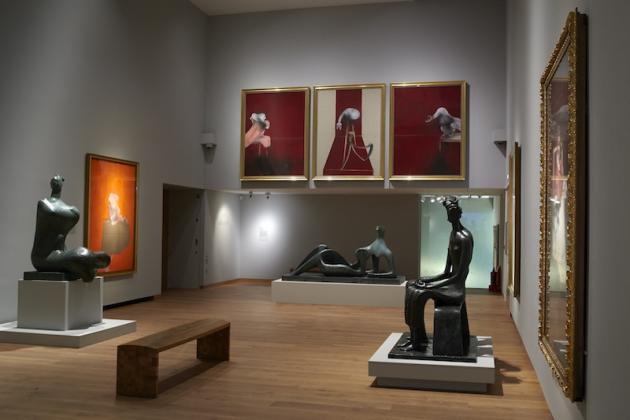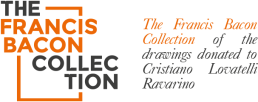September 25, 2013

Happily married establishment figure and Royal College of Art tutor, versus a self-taught sadomasochistic gambler with a fondness for alcohol and the sleek underbelly of Soho.
It is difficult not to see this exhibition as a competition of interests and the interesting; the very personalities of both artists are very evident – one only needs to look at the photographs in the exhibition of both artists studios to see the yawning chasm between them. A curatorial decision that seems to play more to their differences than similarities, and we are reminded that the cult of personality also comes to bare; as the viewer brings a foreknowledge of the infamy of one of these artists as well as his art, as a gilded gutter life in Soho meets the life of a fellow of the British Academy and a public figure. As one enters this exhibition, passed the photographs of Bacon’s Reece Mews studio, with its paint-strewn shambolic glamour, paired with photographs of the sedate and organised ‘school room’ of Moore – the scales of personality are already tipping in Bacon’s favour.
There are two ways in which you can view this exhibition. If prejudice is left at the door along with the misguided cult of personality, comparison of the very dichotomy of these artists can lead to the recognition of shared formal concerns; faces lost, distorted, or abstracted, and for both artists at times even non existent; as the likeness of an individual was of no importance to either man, yet the physicality of the human body, and the subsequent abstraction of form and shape is of paramount importance to both artists visions. What at first are diametrically opposed works do on occasion give way to familiar aesthetic concerns of the shape and weight of the figure.
But it is hard to balance these two artists works. Bacon’s feverish sacks of meat are positively fervent set against Moore’s stolid immovable incapacity; Moore is like a muted child being out-screamed by a naughty sibling.
Where Moore regains footing however is in his drawing. This has a dynamism that frankly I can never find in his sculpture; a sense of movement and even urgency that reflects at least an aspect of the supine frail flesh all around it. It is the only occasion for the artist; when he reflects upon war, that Moore is less kind to the reality of the human form, with slight echoes of Baconian angst, Moore’s tepid beauty receives more pain than is usual and becomes all the more vivid for it – both artists having been influenced in their own way by the realities of war.
But for the most part Moore’s human condition is concrete solidity; the unbreakable skeleton shrouded in bronze – here juxtaposed with Bacon’s fleeting and bloodied flesh; his painting both ‘bruiser and bruised’ – and if viewed as a boxing match between these two giants of British Art; Moore’s fair play is taken advantage of at every Baconian opportunity.
But the second way of viewing this exhibition and secret to finding its success is in trying to imagine that Moore’s sculpture is the three dimensional result which – in some ways at least – Bacon often dreamt of; Expressed in a very sculptural way of painting, and equally expressed by a drunken Bacon who at one time actually turned up at Moore’s door demanding lessons in Sculpture. In fact the similarities between Bacon’s sculptural figures and Moore’s curve of form are often prescient as highlighted by Richard Calvocoressi’s and Martin Harrison’s curatorial decisions, if made almost too obvious on occasion.
There is no denying the comparison between these two artists; Moore’s King and Queen reside as a seemingly permanent weight beside Bacon’s Pope Innocent X, a surface reading of this juxtaposition reveals certain formal similarities between the sculptural heads and the painted; yet that raw kinetic vision of Bacon again causes the once timeless osseus matter of Moore to melt away before your very eyes. Bacon’s Lying Figure and Moore’s Reclining Figure are a striking visual collaboration; but Moore’s sculpture is a physical reality whereas Bacon’s figure is a theatrical construct placed in its own caged environment – and is all the more powerful for its sanguineous decadent fantasy.
In that sense Bacon’s fictional sculptural figures behave like objects in an installation – an object within its own universe – as opposed to Moore’s sculptures that are forever separate and reside in our own.
The curatorial attempt to reference academic similarities is sometimes heavy-handed, but the juxtaposition is of significance, highlighting a core value with wildly different and antithetical results.
But aside from formal and conceptual conceits which are present and of interest, when viewing this exhibition there can be no denial of power; For all the curatorial insistence of equality it seems that the psychological response to our fears will always be greater than that of our desires – as Baconian existential horror out-screams Moore’s muted immortal bones.
Words: Paul Black Photo: Courtesy of The Ashmolean
Bacon Moore: Flesh and Bone, Ashmolean Museum, Oxford until 19 January 2014
